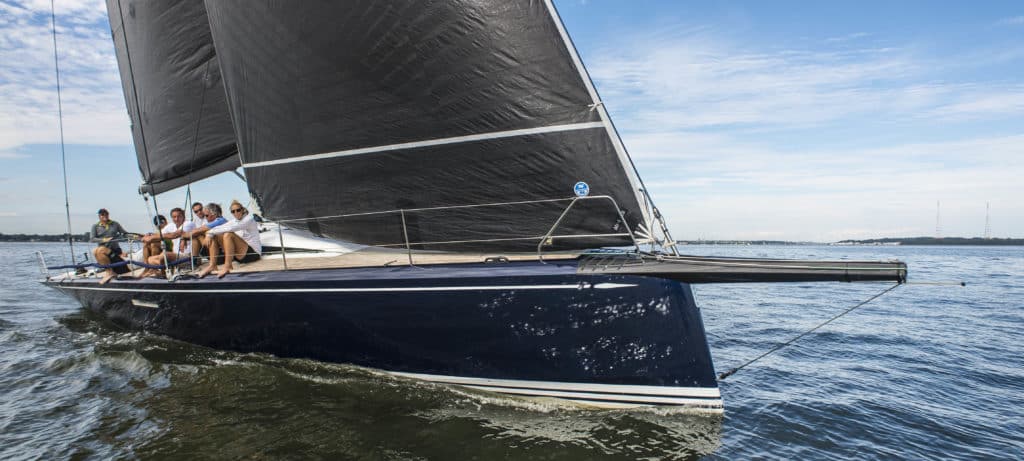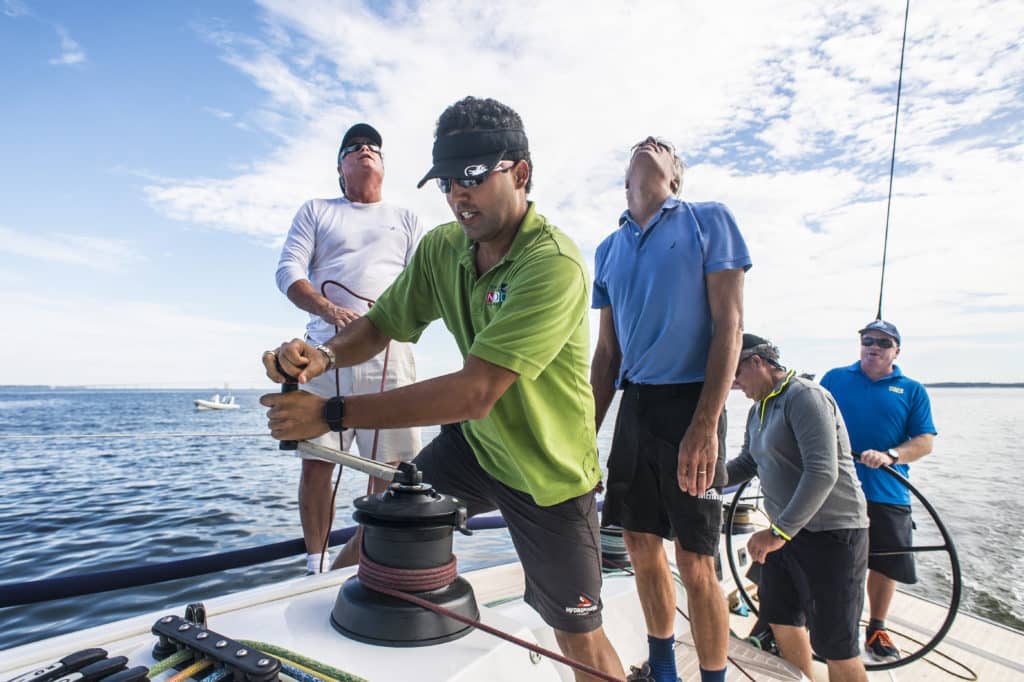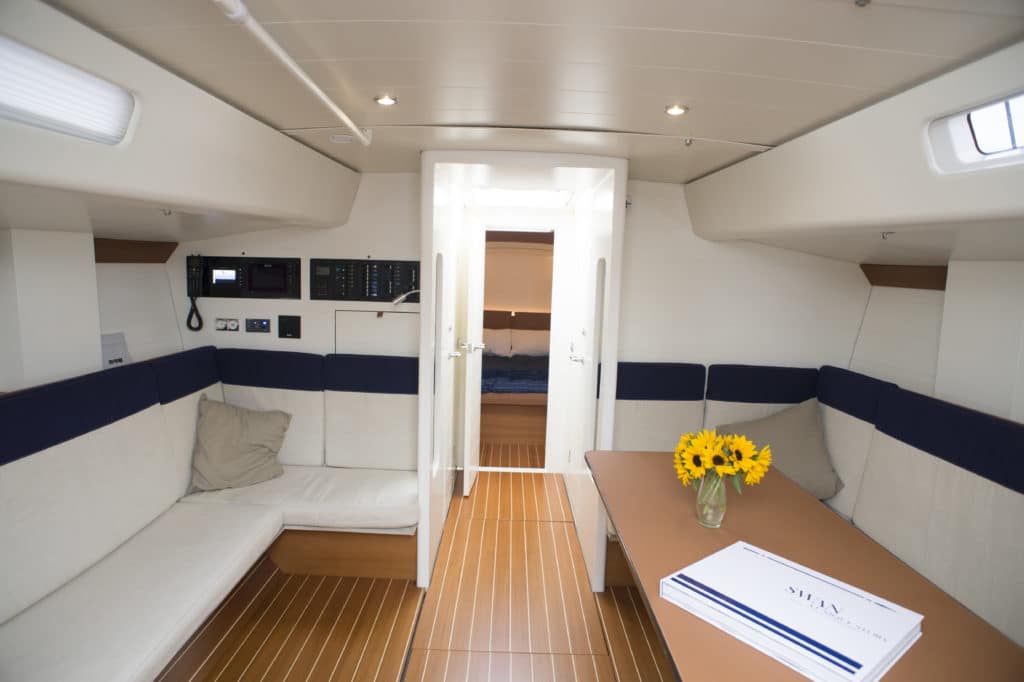
As the most aggressive-looking one-design yet from Nautor’s Swan, the strict one-design ClubSwan 50 piles grand-prix concepts into a straightforward boat that will challenge amateur crews but reward them with speed, especially when the breeze turns on.
Heel — 18 degrees of it — is something to get used to with the ClubSwan 50. Flat is not fast. This Juan Kouyoumdjian creation is the first one-design of Nautor’s Swan new direction. Where similarly sized Swans of yore were laden with cruising interiors, this one is not. It’s a furniture-free 50-foot one-design race boat to be sailed hard and put away wet (with a dehumidifier, of course). For an owner looking to get into TP52-style boat-on-boat racing without the new-boat arms race, the ClubSwan 50, the judges say, is one way to go, here and now.
“It’s definitely more of a one-design-class racer than an offshore racer,” says Stewart. “With the big cockpit and the clean Euro styling, it’s a bitchin’ looking boat on and off the dock, and the class racing will be a lot of fun when you get to fleets of 15 or 20 boats.”
Considering two dozen owners ordered boats within the first year of the ClubSwan 50’s launch, and a robust regatta circuit is already underway in the Mediterranean, Nautor’s Swan is delivering to a demand in Europe for big-boat class racing — that’s where the one-design action is at. The challenge for faraway American owners, however, is the designer’s intentional disregard for any and all measurement rules. Handicap racing is not the point of the ClubSwan 50, nor its selling point. “The development of a one-design class in North America will be the ultimate success,” says Nautor’s Swan’s Tom Lihan, who is tasked with recruiting U.S. owners, “and that’s the goal.”
Roughly $1.3 million will put the boat on the racecourse, with 10 to 12 crew members to feed and dress. According to the judges, it’s a boat that demands a professional bowman and two good sail trimmers. The one-design sail inventory is robust — mainsail, four upwind and four downwind sails, as well as two storm sails — will require proper management on the boat and of the morning sail shuffle to and from the container.

As a wide, high-volume planing hull with twin rudders (scalloped trailing edges to make them unique), the ClubSwan 50 is also a yacht that requires the owner’s/driver’s undivided attention directed toward the instruments. With only six winches and the use of constrictors to free up winches at times, there’s a lot of dancing through maneuvers. There’s a lot to get right and a lot that can go wrong, but that’s the appeal of big-boat racing, right? Clean mark roundings and precision boathandling are what get you to the podium.
A year of development with first-generation hulls resulted in a 700-pound diet, which puts the class minimum weight at 18,086 pounds (“or somewhere around there,” says Lihan). The biggest weight savings were accomplished by upgrading to a carbon keel fin and trimming materials where overbuilt. Exploring Hull No. 3’s deepest recesses, Tom Rich found no flaws with the construction, and overall, the judges gave the build high marks. Back at Nautor’s yard in Finland, CNC machines cut pre-preg carbon cloth before vacuum-bagging and pressure-cooking the hull with all the interior components and structural bulkheads in place.
The deck-stepped rig sits atop a solid carbon interior structure (Lihan calls it the “phone booth”), which creates a clear centerline runway for sails going to and fro. The interior finish, while minimalist and easy to strip for regattas, says Stewart, is appropriate for the boat’s purpose while retaining just enough touch of Swan luxury.

There’s modern minimalism with the deck hardware as well, says Rich, pointing out that the boat has fewer winches than he’d expect on a boat this size. Two cabin-top winches are in high demand, especially during jibes. The big challenge is jibing in 20 knots of wind without a pedestal, Lihan admits. Consequently, ClubSwan 50 class management is exploring an electric option for the cabin tops, or a pedestal. “There is an option for a pedestal, but nobody has ordered one yet,” he says. “You can’t do reach-to-reach blow-through jibes, so you just do proper outside jibes, come out low to get that last bit of sheet, and then point it up again. It’s one-design, so as long as everyone is doing the same thing, does it really matter?”
In strong winds, the ClubSwan 50 will be a powered-up machine, says Allen, one that will be fun and forgiving to drive but demand solid crew work. With class rules in place, owners already taking charge, and sanctioned regattas scheduled in the U.S. in 2019, there’s now a turnkey platform into big-boat, big-boy, one-design racing.
At a Glance
| Built For | One-design Class Racing |
| Judges Liked | Design, Build Quality, All-around Performance |
| Crew Required | 8-10 |
| Price as Tested | $1.3 million |









